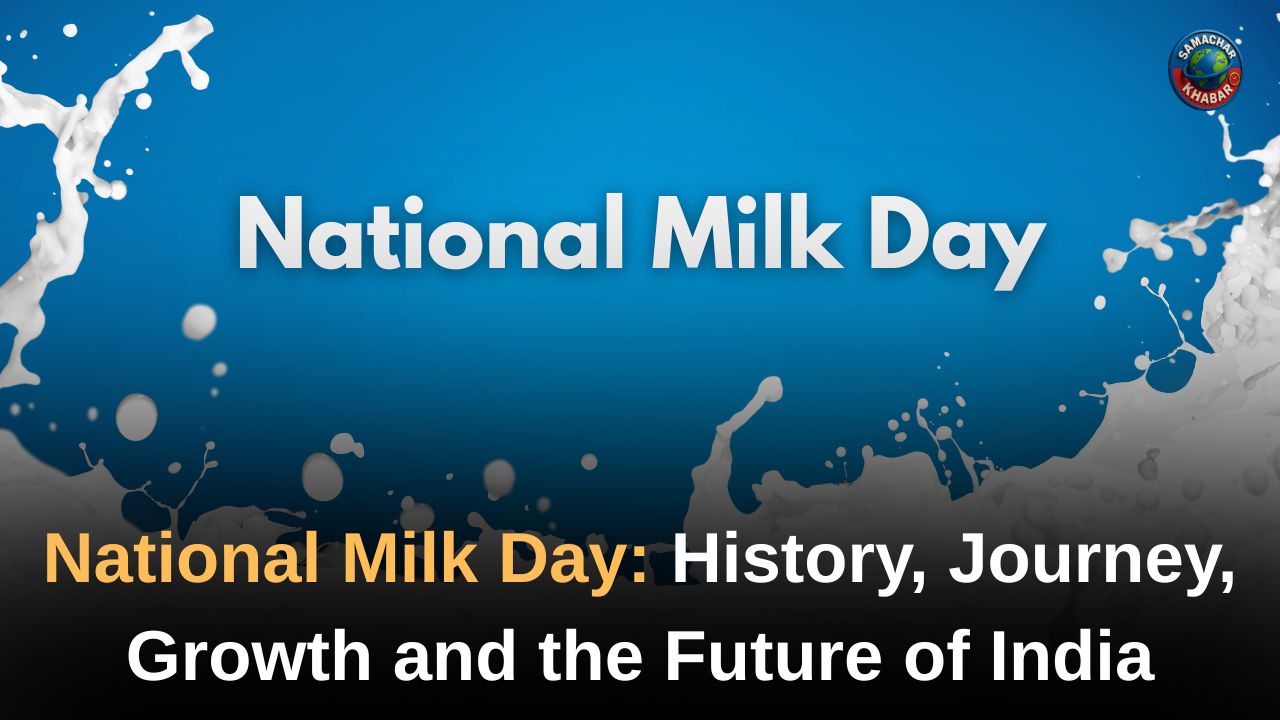India celebrates National Milk Day 2025 today, honouring the birth anniversary of Dr. Verghese Kurien, the visionary behind the White Revolution. His leadership transformed India from a milk-deficient nation into the world’s largest milk producer, a position the country continues to hold with nearly 25% contribution to global output. This year’s observance reflects not only Kurien’s enduring legacy but also the remarkable journey, rapid growth, and ambitious future of India’s dairy sector.
As milk remains a key pillar of nutrition, rural livelihood, and economic strength, National Milk Day 2025 stands as a reminder of how far the nation has come—and the promising road ahead.
Key Takeaways on National Milk Day 2025 and India’s Dairy Progress
- India contributes nearly one-fourth of global milk production.
- Milk output increased from 146.30 million tonnes (2014–15) to 239.30 million tonnes (2023–24).
- Per capita availability rose from 124 g/day to 471 g/day in the same period.
- The dairy sector supports over 8 crore rural households, with women forming 70% of the workforce.
- Flagship schemes: Rashtriya Gokul Mission, NAIP, NPDD, White Revolution 2.0.
- GST reforms reduced tax rates on major dairy products including a cut from 18% to 5% on ice cream.
- India aims to contribute 32% of global milk supply by 2025–26 and expand processing capacity to 100 million litres/day by 2028–29.
India’s Dairy History: From Deficiency to a Global Powerhouse
In the 1950s and 1960s, India faced acute milk shortages despite having the world’s largest cattle population. Milk production grew at barely 1–1.6% annually, leaving the country dependent on imports.
This changed with the establishment of the National Dairy Development Board (NDDB) in 1965 and the launch of Operation Flood in 1970. Modelled on the “Anand pattern,” Operation Flood connected rural milk producers with urban markets, dismantling middlemen exploitation and ensuring fair, stable incomes for farmers. The programme transformed India into a self-sufficient dairy nation and eventually into the world’s largest milk producer in 1998.
In recognition of its national importance, NDDB was declared an Institution of National Importance in 1987.
India’s Dairy Journey: A Decade of Unprecedented Growth
India’s dairy sector has expanded remarkably over the last decade:
| Year | Milk Production (Million Tonnes) | Per Capita Availability |
| 2014–15 | 146.30 | 124 g/day |
| 2023–24 | 239.30 | 471 g/day |
This surge has been supported by a bovine population of 303.76 million and a 27.39% rise in productivity, the highest globally. Milk production from indigenous breeds also grew from 29 to 50 million tonnes, reflecting the success of organised breeding and improved animal health systems.
Rashtriya Gokul Mission: Preserving Breeds and Enhancing Productivity
The Rashtriya Gokul Mission, launched in 2014 and expanded in March 2025, plays a central role in genetic improvement and conservation of indigenous breeds. With a total outlay of ₹3,400 crore, the mission has:
- Benefited 92 million animals
- Reached 56 million farmers
- Conducted 565.55 lakh AI procedures in 2024–25
- Supported advanced tech such as IVF labs and sex-sorted semen
The National Artificial Insemination Programme (NAIP) has performed 14.12 crore inseminations, reaching 5.5 crore farmers, while 38,736 MAITRIs provide doorstep breeding services.
National Programme for Dairy Development: Infrastructure That Powers India
Since 2014–15, the NPDD has been crucial in upgrading India’s dairy infrastructure. Re-aligned in 2021, it includes:
Component A
- Strengthening milk testing laboratories
- Installation of bulk milk coolers
- Primary chilling facilities
Component B
- Expanding cooperative-led markets
- Modernizing processing plants
- Strengthening dairy producer institutions
Key outcomes include:
- Formation or revival of 31,908 cooperatives
- 120.68 lakh kg/day rise in milk procurement
- Establishment of 61,677 village testing labs
- Nearly 6,000 bulk milk coolers
- Greenfield and expansion projects in Mehsana, Indore, Bhilwara, Karimnagar, and Chittoor
Women at the Heart of India’s Dairy Growth
Women form the backbone of India’s dairy ecosystem:
- 70% of the dairy workforce comprises women
- 35% of cooperative members are women
- 48,000 women-led cooperatives operate nationwide
- 16 all-women Milk Producer Organisations support 1.2 million producers
The Shreeja Milk Producer Organisation of Andhra Pradesh earned the International Dairy Federation’s Dairy Innovation Award, exemplifying women-led excellence.
GST Reforms 2025: Making Dairy Affordable and Competitive
At the 56th GST Council Meeting, major tax reductions were approved:
- 0% GST on UHT milk and packaged paneer
- 5% GST on butter, ghee, cheese, dairy beverages (down from 12%)
- Ice cream reduced from 18% to 5%
- Milk cans now taxed at 5%
These reforms ease consumer burdens, lower processing costs, and strengthen dairy value chains for over 8 crore households.
White Revolution 2.0: Expanding Cooperatives and Sustainability
Rolled out in December 2024 for five years (2024–29), White Revolution 2.0 aims to:
- Create 75,000 new dairy cooperatives
- Boost procurement to 1,007 lakh kg/day
- Strengthen 46,422 existing societies
- Establish three Multi-State Cooperative Societies for inputs, natural farming, and carcass management
The programme emphasises sustainable practices, circular economy principles, and increased women participation.
National Gopal Ratna Awards 2025: Celebrating Dairy Excellence
Union Minister Rajiv Rajan Singh will present the National Gopal Ratna Awards 2025 on National Milk Day in New Delhi. Awards will honour:
- Indigenous breed dairy farmers
- Dairy cooperatives and MPOs
- Skilled AI technicians
Cash prizes of ₹5 lakh, ₹3 lakh, and ₹2 lakh will be awarded. The event also includes launches of:
- Breed Multiplication Farms
- Veterinary Infrastructure Guidelines
- Basic Animal Husbandry Statistics 2025
- Flagging off 20 NPDD-assisted milk tankers from Mohali
How Saint Rampal Ji Maharaj Guides Humanity Towards True Nourishment
In a world focused on physical nourishment through milk, Saint Rampal Ji Maharaj emphasizes the deeper need for spiritual nourishment—the kind that purifies the soul and leads to lasting peace. Through the divine teachings of Sat-Bhakti as revealed in the sacred scriptures, He explains that true prosperity comes not only from material progress but from connecting with the Supreme God through the correct method of worship.
His unique spiritual knowledge guides humanity toward a life of purity, compassion, and devotion, reminding society that just as milk sustains the body, true spiritual wisdom sustains the soul.
India’s Dairy Future: A Journey Toward Nutrition, Innovation and Global Leadership
India’s dairy sector is transitioning from a quantity-focused system to one centred on quality, sustainability, nutrition, innovation, and traceability. With rising production, advanced breeding methods, women’s leadership, GST rationalisation, and ambitious processing targets, India is poised to strengthen its global leadership in the coming years.
National Milk Day 2025 stands as a tribute to Dr. Verghese Kurien’s legacy and to millions of farmers who continue to drive India’s dairy revolution forward.
FAQs on National Milk Day 2025
1. Why is National Milk Day 2025 celebrated on 26 November?
National Milk Day is celebrated to honour Dr. Verghese Kurien, whose White Revolution transformed India from a milk-deficient nation to the world’s largest milk producer.
2. What were the major achievements of India’s dairy sector in the last decade?
India increased milk production to 239.30 million tonnes, improved per-capita availability, expanded cooperatives, strengthened AI programmes, and enhanced processing infrastructure nationwide.
3. What is the aim of the Rashtriya Gokul Mission?
Rashtriya Gokul Mission focuses on conserving indigenous breeds, improving genetic potential, expanding artificial insemination, and boosting milk productivity among India’s bovine population.
4. What reforms were announced for the dairy sector under GST?
GST reforms made UHT milk and paneer tax-free, reduced butter, ghee, and dairy beverages to 5 percent, and lowered ice cream GST from 18 percent to 5 percent.
5. What is the objective of White Revolution 2.0?
White Revolution 2.0 aims to establish 75,000 dairy cooperatives, enhance milk procurement, support sustainability, and strengthen India’s position as a global dairy leader.

















